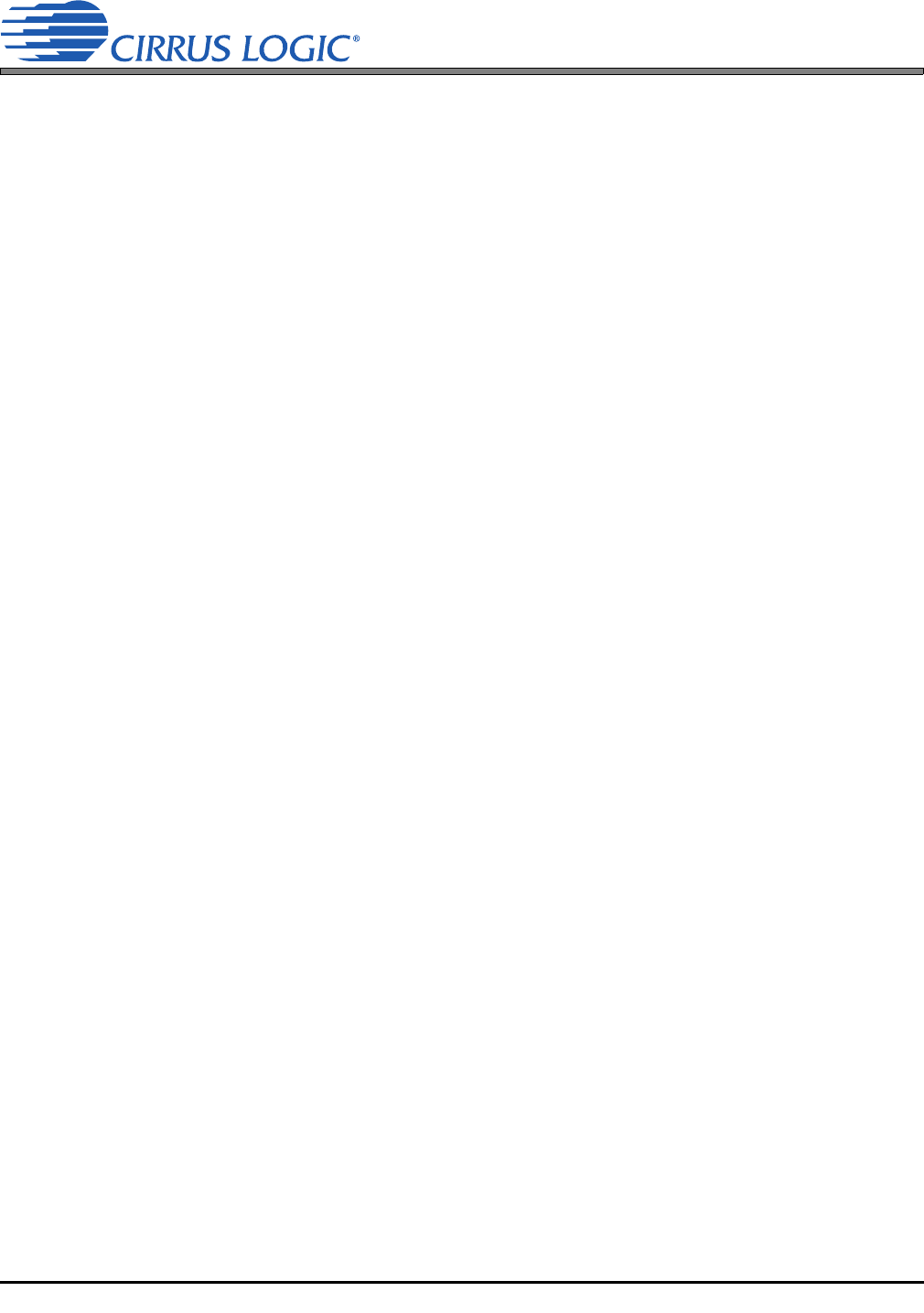User guide
Table Of Contents
- 1. Characteristics and Specifications
- Specified Operating Conditions
- Absolute Maximum Ratings
- Analog Input Characteristics
- A/D Digital Filter Characteristics
- Analog Output Characteristics
- D/A Digital Filter Characteristics
- Switching Characteristics
- Switching Characteristics - Control Port - I²C™ Format
- Switching Characteristics - Control Port - SPI™ Format
- DC Electrical Characteristics
- Digital Interface Characteristics
- 2. Pin Descriptions
- 3. Typical Connection Diagram
- 4. Applications
- 4.1 Overview
- 4.2 Analog Inputs
- 4.3 Analog Outputs
- 4.4 S/PDIF Receiver
- 4.5 Clock Generation
- 4.6 Digital Interfaces
- 4.7 Control Port Description and Timing
- 4.8 Interrupts
- 4.9 Reset and Power-Up
- 4.10 Power Supply, Grounding, and PCB Layout
- 5. Register Quick Reference
- 6. Register Description
- Table 5. DAC De-Emphasis
- Table 6. Receiver De-Emphasis
- Table 7. Digital Interface Formats
- Table 8. ADC One-Line Mode
- Table 9. DAC One-Line Mode
- Table 10. RMCK Divider Settings
- Table 11. OMCK Frequency Settings
- Table 12. Master Clock Source Select
- Table 13. AES Format Detection
- Table 14. Receiver Clock Frequency Detection
- Table 15. Example Digital Volume Settings
- Table 16. ATAPI Decode
- Table 17. Example ADC Input Gain Settings
- Table 18. TXP Output Selection
- Table 19. Receiver Input Selection
- Table 20. Auxiliary Data Width Selection
- 7. Parameter Definitions
- 8. Appendix A: External Filters
- 9. Appendix B: S/PDIF Receiver
- 10. Appendix C: PLL Filter
- 11. Appendix D: External AES3-S/PDIF-IEC60958 Receiver Components
- 12. Appendix E: ADC Filter Plots
- Figure 34. Single-Speed Mode Stopband Rejection
- Figure 35. Single-Speed Mode Transition Band
- Figure 36. Single-Speed Mode Transition Band (Detail)
- Figure 37. Single-Speed Mode Passband Ripple
- Figure 38. Double-Speed Mode Stopband Rejection
- Figure 39. Double-Speed Mode Transition Band
- Figure 40. Double-Speed Mode Transition Band (Detail)
- Figure 41. Double-Speed Mode Passband Ripple
- Figure 42. Quad-Speed Mode Stopband Rejection
- Figure 43. Quad-Speed Mode Transition Band
- Figure 44. Quad-Speed Mode Transition Band (Detail)
- Figure 45. Quad-Speed Mode Passband Ripple
- 13. Appendix F: DAC Filter Plots
- Figure 46. Single-Speed (fast) Stopband Rejection
- Figure 47. Single-Speed (fast) Transition Band
- Figure 48. Single-Speed (fast) Transition Band (detail)
- Figure 49. Single-Speed (fast) Passband Ripple
- Figure 50. Single-Speed (slow) Stopband Rejection
- Figure 51. Single-Speed (slow) Transition Band
- Figure 52. Single-Speed (slow) Transition Band (detail)
- Figure 53. Single-Speed (slow) Passband Ripple
- Figure 54. Double-Speed (fast) Stopband Rejection
- Figure 55. Double-Speed (fast) Transition Band
- Figure 56. Double-Speed (fast) Transition Band (detail)
- Figure 57. Double-Speed (fast) Passband Ripple
- Figure 58. Double-Speed (slow) Stopband Rejection
- Figure 59. Double-Speed (slow) Transition Band
- Figure 60. Double-Speed (slow) Transition Band (detail)
- Figure 61. Double-Speed (slow) Passband Ripple
- Figure 62. Quad-Speed (fast) Stopband Rejection
- Figure 63. Quad-Speed (fast) Transition Band
- Figure 64. Quad-Speed (fast) Transition Band (detail)
- Figure 65. Quad-Speed (fast) Passband Ripple
- Figure 66. Quad-Speed (slow) Stopband Rejection
- Figure 67. Quad-Speed (slow) Transition Band
- Figure 68. Quad-Speed (slow) Transition Band (detail)
- Figure 69. Quad-Speed (slow) Passband Ripple
- 14. Package Dimensions
- 15. Ordering Information
- 16. References
- 17. Revision History

DS583F2 57
CS42516
6.11.3 AUTO-MUTE (AMUTE)
Default = 1
0 - Disabled
1 - Enabled
Function:
The digital-to-analog converters of the CS42516 will mute the output following the reception of 8192
consecutive audio samples of static 0 or -1. A single sample of non-static data will release the mute.
Detection and muting is done independently for each channel. The quiescent voltage on the output
will be retained, and the MUTEC pin will go active during the mute period. The muting function is af-
fected, similar to volume control changes, by the Soft and Zero Cross bits (SZC[1:0]).
6.11.4 SERIAL AUDIO INTERFACE SERIAL PORT MUTE (MUTE SAI_SP)
Default = 0
0 - Disabled
1 - Enabled
Function:
When enabled, the Serial Audio Interface port (SAI_SP) will be muted.
6.11.5 SOFT VOLUME RAMP-UP AFTER ERROR (RMP_UP)
Default = 0
0 - Disabled
1 - Enabled
Function:
An un-mute will be performed after executing a filter mode change, after a MCLK/LRCK ratio change
or error, and after changing the Functional Mode. When this feature is enabled, this un-mute is affect-
ed, similar to attenuation changes, by the Soft and Zero Cross bits (SZC[1:0]). When disabled, an
immediate un-mute is performed in these instances.
Note: For best results, it is recommended that this bit be used in conjunction with the RMP_DN bit.
6.11.6 SOFT RAMP-DOWN BEFORE FILTER MODE CHANGE (RMP_DN)
Default = 0
0 - Disabled
1 - Enabled
Function:
A mute will be performed prior to executing a filter mode or de-emphasis mode change. When this
feature is enabled, this mute is affected, similar to attenuation changes, by the Soft and Zero Cross
bits (SZC[1:0]). When disabled, an immediate mute is performed prior to executing a filter mode or
de-emphasis mode change.
Note: For best results, it is recommended that this bit be used in conjunction with the RMP_UP bit.










